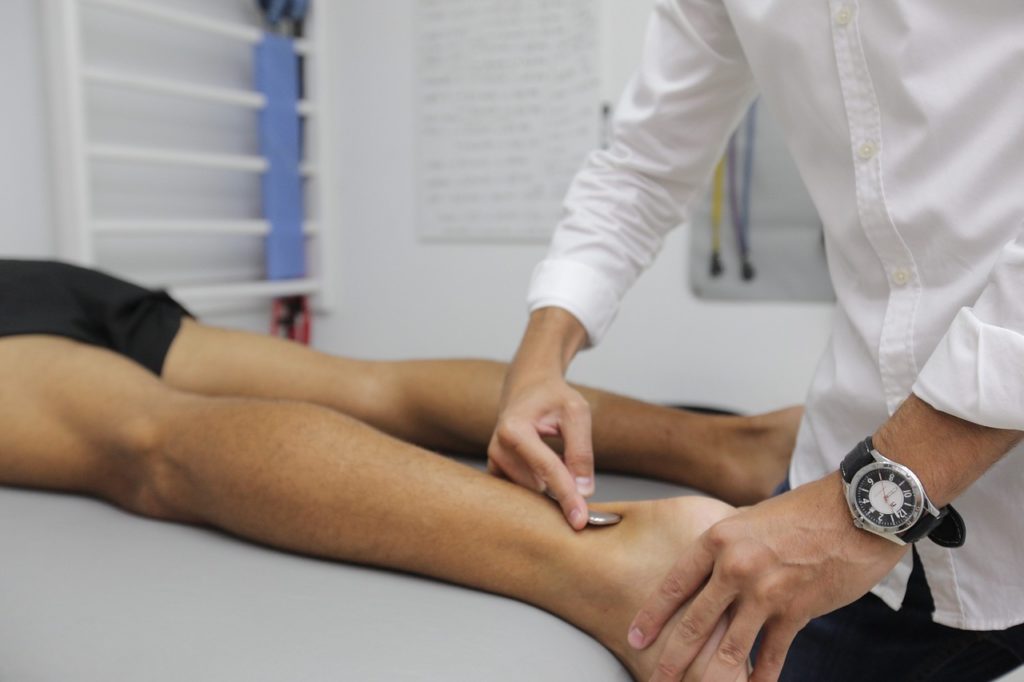 When it comes to health, nobody likes surprises.
When it comes to health, nobody likes surprises.
Knowing what to expect from a procedure or treatment plan not only helps you determine whether it’s actually the right course of action for your situation; it also helps you prepare yourself mentally, emotionally, and financially.
The term “physical therapy” can mean a LOT of different things, depending on the type of physical therapy, the condition being treated, and the therapist you choose.
Learning what to expect at a physical therapy session for plantar fasciitis, how to choose a physical therapist that’s right for your situation, the average cost of physical therapy, and the types of stretches and exercises you can expect will help you make informed decisions and set your mind at ease:

What Is Physical Therapy?
For the majority of people, physical therapy for plantar fasciitis becomes a consideration after foot surgery, or if more conservative treatment methods aren’t working.
Physical therapy is a combination of supervised manual therapy and a personalized treatment plan intended to restore mobility, reduce pain, and improve the health of the arch. Physical therapists typically have a degree in health sciences, nursing, sports medicine, or physical therapy. No matter which physical therapist you choose to help you recover from surgery or improve your difficult-to-treat plantar fasciitis, you can expect assistance in the following ways:
- One-on-one, supervised guidance as you work through a series of stretches and exercises to improve mobility, flexibility, and arch strength
- A resource for education about your unique situation
- Access to treatments like electrical stimulation and ultrasound, as they are needed
- Help create a plan for at-home physical therapy to supplement in-office physical therapy
Before you start physical therapy, you’ll want to make sure that you’ve dotted your i’s and crossed your t’s for insurance purposes. Some physical therapists require a referral from another physician, while others don’t. If you’re undergoing physical therapy after surgery for plantar fasciitis, you’ll want to be sure to arrange and confirm everything before your surgery to avoid expensive surprises post-op.
Choosing a Physical Therapist for Plantar Fasciitis

While every physical therapist’s goal is to help you recover and literally get back on your feet, there’s a wide variety of physicians and practice types to choose from.
Do some research online and stop by a few offices to get a flavor of the types of practices in your area. Some will be quite small and intimate, with only one or two physical therapists on staff. Others will employ many physical therapists and may be part of a large hospital network. While your choice of physician is the most important, you’ll also want to choose a location, organization, and environment you feel comfortable with.
When choosing your physical therapist, look for reviews online and ask for suggestions in local support groups for plantar fasciitis. When possible, find a physical therapist who specializes in rehabilitating the feet and arches. Don’t be afraid to ask about costs upfront, and to make sure that your insurance is covered, if you have it.
What to Expect at Physical Therapy for Plantar Fasciitis
The biggest question most people have about what to expect from physical therapy for plantar fasciitis is, “will it hurt?” The answer, of course, depends on the type of therapy you and your physical therapist choose. However, in general, guided stretching and exercises shouldn’t hurt. You may feel some discomfort as you stretch and strengthen damaged and weak muscles and ligaments, especially during the postoperative period, but there’s no need to brace yourself for severe pain.

That said, communication is very important. While your physical therapist is a trained professional, he or she isn’t a mind reader. If something hurts or feels wrong, don’t be shy about speaking up. Let your physical therapist know, so your position or treatment can be adjusted properly.
The other big question many people have about what to expect from physical therapy is “how long will it take?” or “how many sessions will I need?” Again, the answer depends a great deal on a few factors, including how long you have been dealing with plantar fasciitis, whether or not you are recovering from surgery, your particular body and other coexisting conditions, and how diligent you are about supplementing in-office physical therapy with at-home treatment. Physical therapy can be a process of as little as a few weeks, or many months, depending on your unique situation.
Physical Therapy Costs
The cost of physical therapy for plantar fasciitis depends on a combination of the following factors:
- Number of sessions you need
- The complexity of the problem, including other conditions you’re dealing with simultaneously
- The therapist you choose and his or her treatment plan
- How much you’re able–and willing–to supplement your physical therapy with at-home exercises and activities
- Whether or not your physical therapy sessions are covered by insurance
Expect to pay anywhere from $10-$75 per session, with insurance, and between $50-$350 per session without insurance. Smaller practices are often less expensive and may be a good place to start if you don’t have insurance. You’ll also want to plan for costs that may arise throughout the course of your physical therapy, based on recommendations by your physical therapist such as night splints, orthotics for plantar fasciitis, and heel wraps.
Common Physical Therapy Stretches and Exercises
Your physical therapist will work with you to create a specialized treatment plan. He or she will guide you through stretches and manual therapy like massage to help strengthen and improve flexibility in the arch and its supporting muscles and tendons. Here are five of the most common types of exercises and stretches you’re likely to encounter in physical therapy. With a little creativity, you can also perform these types of stretches at home:
Arch stretches:
Stretches that improve strength and flexibility of the arch are critical to physical therapy since the arch is the weight-bearing mechanism that has become compromised through plantar fasciitis. Your physical therapist will guide you through stretches that engage, lengthen, and improve circulation in this vital ligament.
At-home support: Stretch your arch using a simple water bottle or tennis ball.
Toe stretches:
Exercises that strengthen the toes will also build strength and flexibility in the muscles and ligaments throughout the foot. Your physical therapist may guide you through stretches to grab small objects or grasp with your toes.
At-home support: Strengthen your toes by grasping for pebbles or marbles.
Ankle mobility stretches:
Limited ankle mobility can play a factor in plantar fasciitis since an inflexible ankle impedes the arch from absorbing impact properly. Your physical therapist may use stretches designed to help you improve the range of motion and flexibility in your ankles.
At-home support: Use a staircase stretch to build and improve ankle mobility.
Achilles tendon stretches:
A tight Achilles tendon can lead to gait abnormalities that take a serious toll on your arch. Your therapist may use stretches designed to lengthen and loosen a tight Achilles tendon to help improve your gait.
At-home support: The wall and book stretch help strengthen and stretch the Achilles tendon.
Calf stretches:
The calves can become tight and limited in proper function either in response to plantar fasciitis or as a contributing cause of plantar fasciitis. Your physical therapist may work on stretching and lengthening your calves to allow your legs and feet to work together properly.
At-home support: Wall squats can help lengthen and stretch the calves at home.
In addition to asking you to supplement your physical therapy at home with stretches for plantar fasciitis, your physical therapist will likely encourage you to continue conservative, at-home treatment options. These tried-and-true treatments can support and improve the effectiveness of your in-office physical therapy and include wearing orthotics, icing as needed, resting as much as possible, and using NSAIDs for pain and inflammation as needed.
Physical therapy can be an incredibly helpful resource for recovery and support, especially for difficult-to-treat cases of plantar fasciitis, or after surgery during the healing process. With the right physical therapist on your side, your journey toward healing can be expedited and improved.
Common Physical Therapy Treatments
| Ultrasound | Graston | TENS Therapy |
| Laser Therapy | Osteopathic Manipulative Treatment | Soft Tissue Mobilization |
| Dry Cupping | Cryotherapy | Active Release Technique |




Good advice ! Thanks !
How does one go about finding a PF PT?
Hi JoAnn, your insurance or doctor should be able to refer you to a good physical therapist. Many also have reviews and ratings on Google and Yelp, so you can see how other people liked their services!
Contact the Canadian Physiotherapy Association
Have dealt with PF for almost a year. Many tests (MRI, X-rays,nerve conductions, cortisone shots and exercises) slowly getting better with orthotics and stretches.